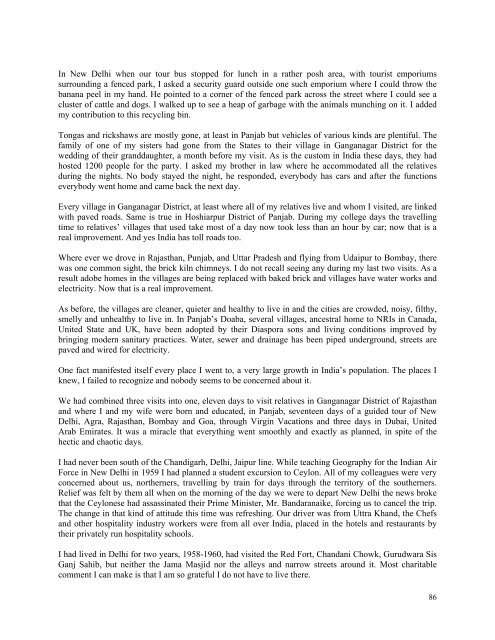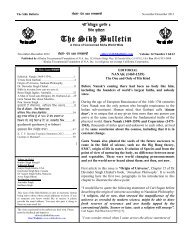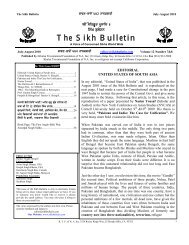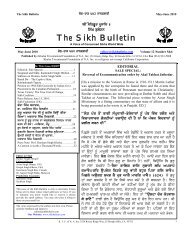Selected Editorials - The Sikh Bulletin
Selected Editorials - The Sikh Bulletin
Selected Editorials - The Sikh Bulletin
You also want an ePaper? Increase the reach of your titles
YUMPU automatically turns print PDFs into web optimized ePapers that Google loves.
In New Delhi when our tour bus stopped for lunch in a rather posh area, with tourist emporiums<br />
surrounding a fenced park, I asked a security guard outside one such emporium where I could throw the<br />
banana peel in my hand. He pointed to a corner of the fenced park across the street where I could see a<br />
cluster of cattle and dogs. I walked up to see a heap of garbage with the animals munching on it. I added<br />
my contribution to this recycling bin.<br />
Tongas and rickshaws are mostly gone, at least in Panjab but vehicles of various kinds are plentiful. <strong>The</strong><br />
family of one of my sisters had gone from the States to their village in Ganganagar District for the<br />
wedding of their granddaughter, a month before my visit. As is the custom in India these days, they had<br />
hosted 1200 people for the party. I asked my brother in law where he accommodated all the relatives<br />
during the nights. No body stayed the night, he responded, everybody has cars and after the functions<br />
everybody went home and came back the next day.<br />
Every village in Ganganagar District, at least where all of my relatives live and whom I visited, are linked<br />
with paved roads. Same is true in Hoshiarpur District of Panjab. During my college days the travelling<br />
time to relatives’ villages that used take most of a day now took less than an hour by car; now that is a<br />
real improvement. And yes India has toll roads too.<br />
Where ever we drove in Rajasthan, Punjab, and Uttar Pradesh and flying from Udaipur to Bombay, there<br />
was one common sight, the brick kiln chimneys. I do not recall seeing any during my last two visits. As a<br />
result adobe homes in the villages are being replaced with baked brick and villages have water works and<br />
electricity. Now that is a real improvement.<br />
As before, the villages are cleaner, quieter and healthy to live in and the cities are crowded, noisy, filthy,<br />
smelly and unhealthy to live in. In Panjab’s Doaba, several villages, ancestral home to NRIs in Canada,<br />
United State and UK, have been adopted by their Diaspora sons and living conditions improved by<br />
bringing modern sanitary practices. Water, sewer and drainage has been piped underground, streets are<br />
paved and wired for electricity.<br />
One fact manifested itself every place I went to, a very large growth in India’s population. <strong>The</strong> places I<br />
knew, I failed to recognize and nobody seems to be concerned about it.<br />
We had combined three visits into one, eleven days to visit relatives in Ganganagar District of Rajasthan<br />
and where I and my wife were born and educated, in Panjab, seventeen days of a guided tour of New<br />
Delhi, Agra, Rajasthan, Bombay and Goa, through Virgin Vacations and three days in Dubai, United<br />
Arab Emirates. It was a miracle that everything went smoothly and exactly as planned, in spite of the<br />
hectic and chaotic days.<br />
I had never been south of the Chandigarh, Delhi, Jaipur line. While teaching Geography for the Indian Air<br />
Force in New Delhi in 1959 I had planned a student excursion to Ceylon. All of my colleagues were very<br />
concerned about us, northerners, travelling by train for days through the territory of the southerners.<br />
Relief was felt by them all when on the morning of the day we were to depart New Delhi the news broke<br />
that the Ceylonese had assassinated their Prime Minister, Mr. Bandaranaike, forcing us to cancel the trip.<br />
<strong>The</strong> change in that kind of attitude this time was refreshing. Our driver was from Uttra Khand, the Chefs<br />
and other hospitality industry workers were from all over India, placed in the hotels and restaurants by<br />
their privately run hospitality schools.<br />
I had lived in Delhi for two years, 1958-1960, had visited the Red Fort, Chandani Chowk, Gurudwara Sis<br />
Ganj Sahib, but neither the Jama Masjid nor the alleys and narrow streets around it. Most charitable<br />
comment I can make is that I am so grateful I do not have to live there.<br />
86
















